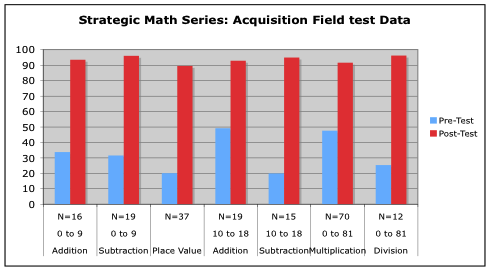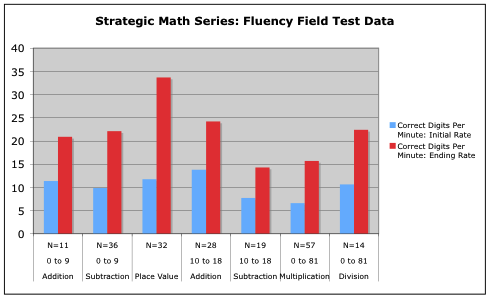Additional information
| Dimensions | 8.5 × 11 in |
|---|---|
| Cover | Paperback |
| Dimensions (W) | 8 1/2" |
| Dimensions (H) | 11" |
| Page Count | 114 |
| Publisher | CRL |
| Year Printed | 1993 |
Ten, twenty, thirty, forty… as numbers grow, so too does the difficulty for solving the problems in which they appear. To make this process easier over the long run, students must understand the concept of place value from the beginning. Within the Place Value: Discovering Tens and Ones program, students learn to understand that double-digit numbers are nothing more than groups of tens and ones. By gaining this understanding, they acquire the foundation for solving problems that contain even larger numbers. The manual provides students with ample opportunities to rename single and double-digit numbers into groups of tens and ones, add and subtract double-digit numbers that do not involve regrouping, and expand their problem-solving ability with word problems. They work through the concrete, representational, and abstract stages as they solve a variety of problems. Along the way, students work with timed practice activities and the ever-popular pig games.
| Dimensions | 8.5 × 11 in |
|---|---|
| Cover | Paperback |
| Dimensions (W) | 8 1/2" |
| Dimensions (H) | 11" |
| Page Count | 114 |
| Publisher | CRL |
| Year Printed | 1993 |
Study 1 Overview
The Place Value Program is used to teach students place-value concepts and skills. This study was conducted to compare two methods of teaching basic place-value skills: a concrete, semiconcrete, and abstract teaching sequence versus an abstract teaching method. The 24 participants were elementary and middle-school students with learning disabilities (LD). They were randomly selected into two groups of 12 students each. Their regularly assigned teachers provided the instruction after receiving training. Two types of measures were administered at three points in time: immediately following instruction, one week after instruction was terminated, and three weeks after instruction ended. The acquisition test measured students’ skill at identifying ones and tens in two-digit numbers; the generalization test measured students’ skill at identifying ones and tens in three- and four-digit numbers (i.e., a skill not taught in the program). A 2 x 3 mixed design with one between groups factor (instructional method) and one within (performance over time) group factor was employed. A multivariate analysis of variance was used to determine whether differences were present related to the different instructional methods used. This was followed by two univariate analyses of variance.
Results
Students who were taught place-value skills using the concrete-to-abstract teaching method earned scores that were significantly higher than the scores of students who participated in the abstract teaching method on some of the posttest measures. The MANOVA revealed a significant main effect for instruction method, F(2, 21) = 4.49, p < .05. A univariate ANOVA revealed a significant main effect for the instructional method variable on the acquisition tests, F(1, 22) = 8.79, p < .01, in favor of the experimental instruction. No differences were found on the generalization measure.
Conclusions
This study shows that the concrete-to-abstract teaching sequence that is used in the Math Strategies Curriculum and particularly in the Place Value Program is more effective than an abstract-only teaching method. It also shows that generalization to untaught, higher-level place value skills does not occur without explicit instruction on those skills.
Reference
Peterson, S. K., Mercer, C. D., & O’Shea, L. (1988). Teaching learning disabled students place value using the concrete-to-abstract sequence. Learning Disabilities Research, 4(1), 52-56.
Study 2 Overview
A field test was conducted that involved 6 teachers and 30 elementary students who were experiencing difficulties learning math. This student group included 21 students with learning disabilities, 3 students with emotional disabilities, and 6 students who were at-risk for school failure. The students in this field test received three lessons at the concrete level, three lessons at the representational level, and three levels at the abstract level from the Place Value: Discovering Tens and Onesprogram.
Results
On the pretest, the students’ mean place value score was 20%. On the posttest, the students’ mean score was 88%. On the retention test administered 5 to 10 days after instruction ended, the students’ mean place value score was 96%.
Conclusions
The results of this field test show that students with difficulties in math can acquire place value skills using the Place Value: Discovering Tens and Ones program. More importantly, students are able to retain their learning at very high levels.
Reference
Mercer, C. D., & Miller, S. P. (1992). Teaching students with learning problems in math to acquire, understand, and apply basic math facts. Remedial and Special Education, 13(3), 19-35, 61.
Study 3 Overview
Multiple field tests were conducted that involved 56 teachers and 248 elementary students who were experiencing difficulties learning math. These field tests took place in seven school districts in self-contained, resource, and general education classes. The teachers were trained to use programs in the Math Strategies Series. Different groups of students were taught addition facts, subtraction facts, multiplication facts, division facts, and place value concepts and skills, depending on their needs.
Results
Substantial gains were made by the students in all areas. See the figures below for the results in each math area. Figure 1 shows the results on untimed acquisition tests, and Figure 2 shows the results on timed proficiency tests (i.e., fluency tests). The number of students participating in each field test is shown beneath each pair of bars on the graph.
Figure 1: Student performance on acquisition tests

Figure 2: Student performance on fluency tests

The results for the Place Value program are shown in the third pair of bar graphs in each figure. Students earned a mean score of 20% on the acquisition pretest and 89% on the posttest. They correctly answered 12 place-value tasks per minute in baseline and 34 tasks per minute after instruction.
Conclusions
The results of this field test show that students with difficulties in math can acquire place value skills using the Place Value: Discovering Tens and Ones program. More importantly, students are able to retain their learning at very high levels.
Reference
Mercer, C. D., & Miller, S. P. (1992). Teaching students with learning problems in math to acquire, understand, and apply basic math facts. Remedial and Special Education, 13(3), 19-35, 61.

Susan P. Miller, Ph.D.
Affliations
My Background and Interests
I am a Professor of Special Education at the University of Nevada Las Vegas (UNLV). In this role, I teach courses in learning strategies, instructional methodology, and leadership. My research interests focus on learning strategies and mathematics interventions. I’ve had the opportunity to share much of what I know as author of Validated Practices for Teaching Students with Diverse Needs and Abilities and as co-author of Designing and Implementing Mathematics Instruction for Students with Diverse Learning Needs, and the Strategic Math Series. Prior to joining the faculty at UNLV, I worked as Program Administrator for the Multidisciplinary Diagnostic and Training Program at the University of Florida. Additionally, I’ve taught students with and without disabilities at the elementary and secondary levels. As a high-school general education teacher, I taught social science courses and compensatory mathematics. As a junior-high general education teacher, I taught geography and American history. As a middle-school special education teacher, I taught reading, and as an elementary diagnostic classroom teacher, I taught math, reading, and language arts to students with medical, learning, and behavioral challenges.
The Story Behind the Strategic Math Series
Arithmetic and mathematics were my least preferred subjects in the school curricula as a child and teenager. I spent a good bit of time memorizing procedures to get correct answers without truly understanding the meaning behind those procedures. From an early age, becoming a teacher was high on my list of goals, but I never imagined that mathematics would be the subject I’d teach. As fate would have it, my teaching assignments at both the elementary and high school levels included mathematics. It wasn’t until I began teaching math that I realized it was not math that I had disliked all those years, but it was the way I had been taught math. That realization launched my dedication to finding better ways to teach this complex area of the curriculum. Cecil Mercer, my doctoral mentor at the University of Florida (Go Gators!), also was interested in determining effective ways to teach mathematics. Thus, when dissertation time arrived, we designed a study that involved the use of the Concrete-Representational-Abstract (CRA) teaching sequence to help students acquire an understanding of place value. The positive results obtained in this dissertation study caused us to launch a series of studies and field tests related to teaching basic math facts using the CRA sequence with integrated strategy instruction, a graduated word problem sequence, math timings, and numerous PIG dice games to make math practice fun. The positive outcomes for students and positive feedback from their teachers motivated us to share our results with Jean Schumaker and Don Deshler, and shortly thereafter the Strategic Math Series was born!
My Thoughts about the Strategic Math Series
I have enjoyed witnessing the positive effects of Strategic Math Series instruction on students who struggle with their basic math facts and place-value skills. Students who receive this instruction develop conceptual understanding, learn to use procedural strategies, and develop fluency related to the basic math facts. Students also learn to attack word problems without fear, and they absolutely love the Pig Games! Engagement in these games provides the extensive practice needed for skill mastery and keeps student motivation high. Mathematics is hierarchical with one skill building on the next. Mastery of basic math facts and place value understanding is needed for students to progress through the mathematics curriculum. Without this understanding, higher level mathematics skills are a tremendous challenge for teachers to teach and students to learn. Fortunately, this program sets students up for future success in their mathematics endeavors.
Teacher and Student Feedback on the Strategic Math Series
Teachers routinely tell me that the math strategies instruction is easy to implement and that their students love it. They report that the students really understand addition, subtraction, place value, multiplication, and division when they finish the instructional lessons. Teachers who use a variety of comprehensive mathematics programs say that the Strategic Math Series is a wonderful supplement to these programs. They note that students need this supplemental instruction and practice to be successful in math. When Cecil Mercer and I conducted the field tests for the series, we had opportunities to talk with many teachers and to read their written feedback about the lessons. The 56 teachers involved in these field tests were overwhelmingly positive and indicated they would continue to use the program even though the field tests were complete. Written feedback from the students was very positive as well. I recently received a letter from a parent-volunteer who was using the program with her son and another child in an elementary resource room setting. She noted that the students were engaged and enthusiastic and wrote, “I’m so excited about how rapidly both children are progressing and what good feelings the children are experiencing due to their success.”
My Contact Information
Susan P. Miller, Ph.D.
Professor
Department of Special Education-Box 453014
University of Nevada Las Vegas
Las Vegas, NV 89154
Email: millersp@unlv.nevada.edu
Work Phone: 702 895-1108

 Professional Development Digital Program for Strategic Tutoring Center Directors...
Professional Development Digital Program for Strategic Tutoring Center Directors...